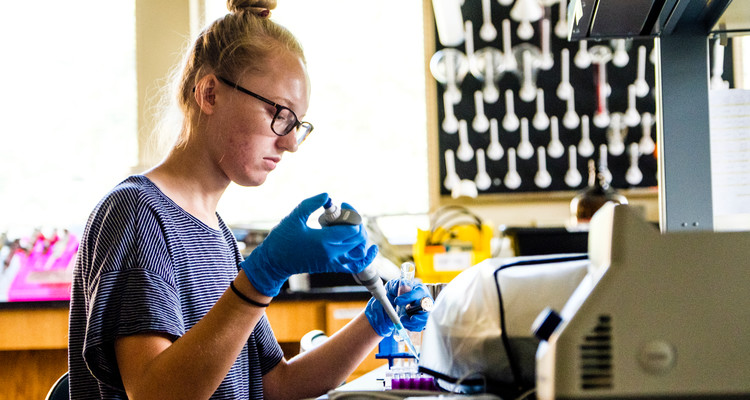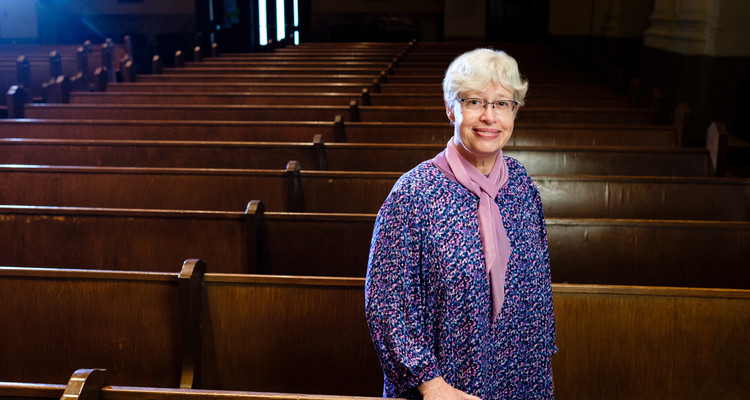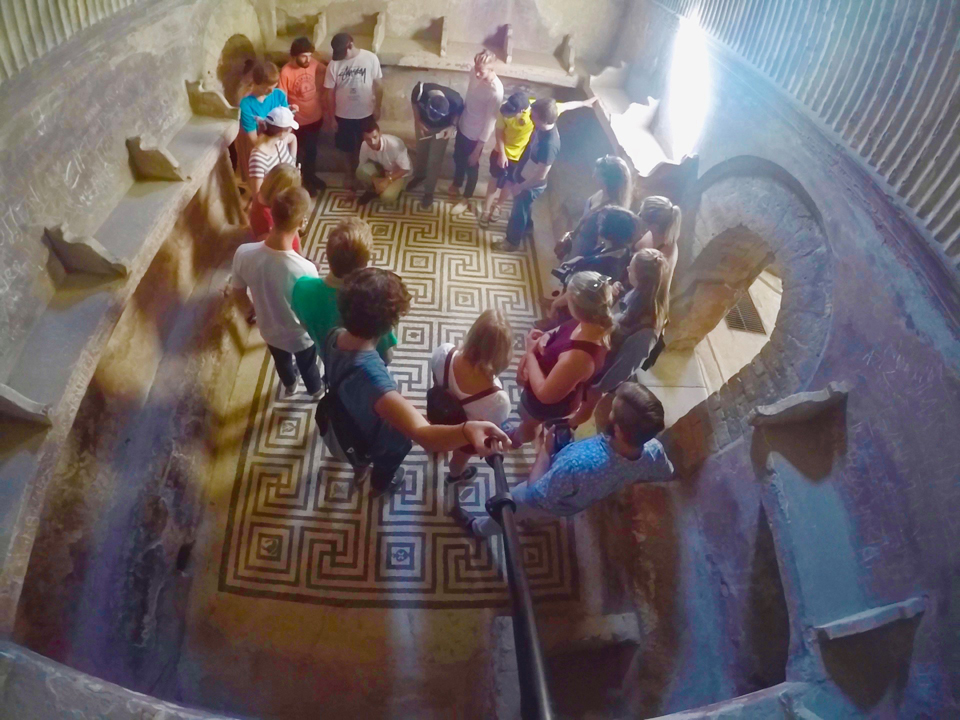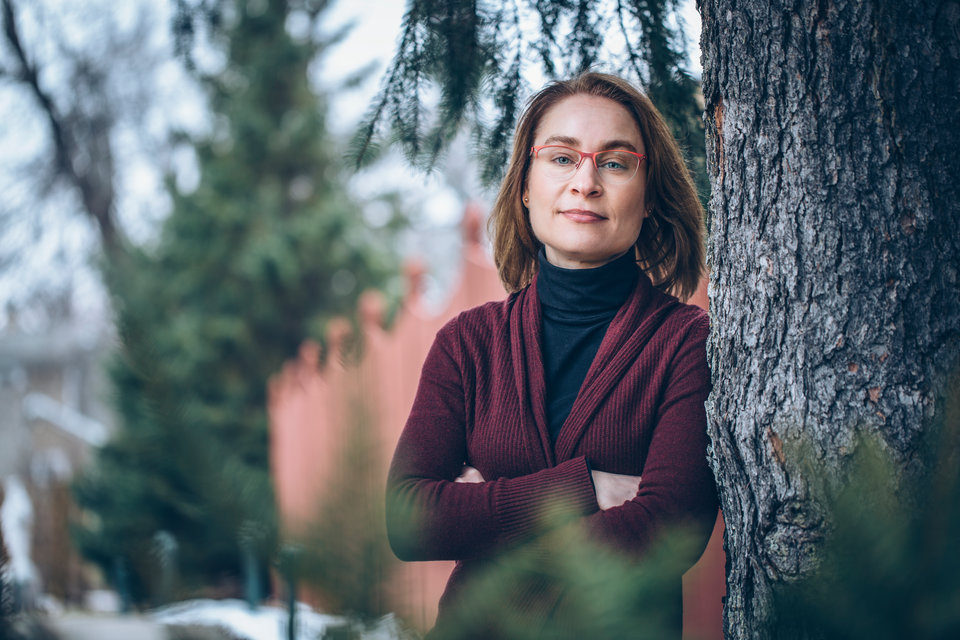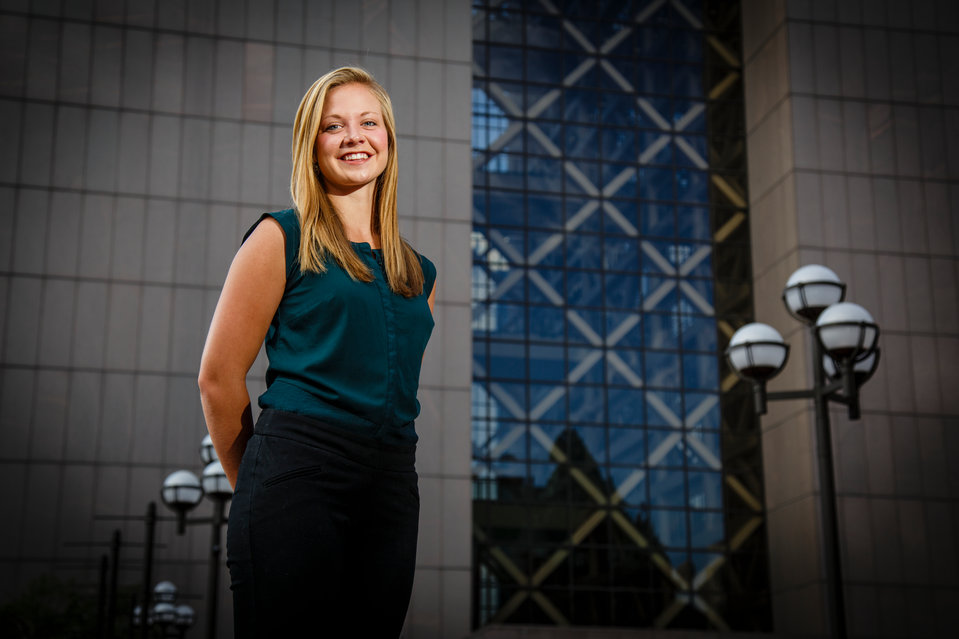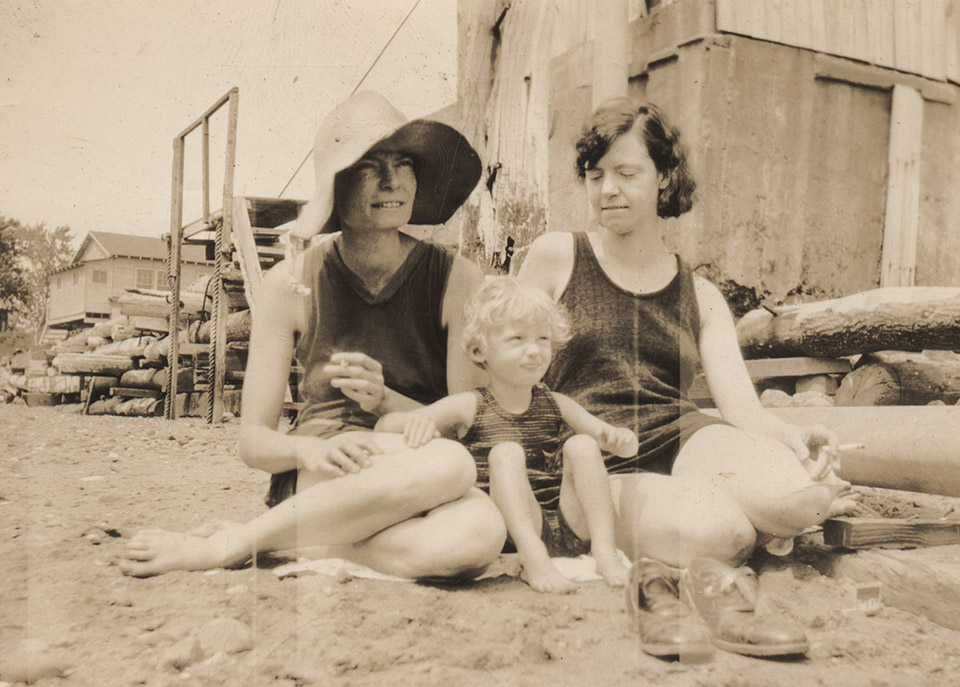Most chemists will say that students learn chemistry by doing chemistry. One of my own mentors used to say, “Education is not a spectator sport.” Research provides a unique opportunity for hands-on work and the prospect of finding a solution to a problem no one else has solved – a fun way (and some would say the only way) to educate chemists.
Each summer, Owens Hall buzzes with activity as more than 50 students carry out research alongside faculty mentors. The summer provides time for science, and nothing can improve the chances of success more than applying one’s full attention to a task.
Here is what a walk around the department on a summer day is like.
Professor Bill Ojala’s group occupies a corner lab at the end of the hall, but in the summer the students also colonize a bigger teaching lab around the bend. Ojala and his students study the solid state. They are trying to describe the most important interactions between molecules that cause them to align the way they do in the process of forming a solid crystal. Ojala’s students use a systematic approach: They synthesize families of compounds that are structurally similar to each other, and then coax them to crystallize. This step is mostly an art. Many molecules are reluctant to form nicely ordered solid patterns. Others can form multiple crystalline patterns, sometimes simultaneously within the same container. If a large enough crystal forms, then the students record its X-ray diffraction pattern, which can be interpreted to create a 3-D diagram of how molecules are packed.
This type of work addresses questions about what rules nature follows. The answers eventually will enable chemists to make predictions and, possibly, to engineer properties into new materials. For example, it can be beneficial for drug design and the formulation of medicines reach their targets more efficiently.
After her first summer of working alongside Ojala in his lab, Brianna Vickerman ’16 found the research so engaging that she switched her major to chemistry.
“It quickly became clear to me how much I enjoyed working at the benchtop and running reactions,” Vickerman said. “I enjoyed asking questions and trying to answer them. I realized that the discovery and acquisition of knowledge was what drew me to chemistry in the first place, and I knew a futurecareer performing research was a perfect fit for me.”
MAKING NEW MATERIALS
On the other side of the hall is professor Eric Fort’s lab. His research students are usually the first to arrive around 8 a.m. They switch on the radio as they put on their lab coats, complete with the group’s own logo. The lab is not big, just large enough to fit a Chevy Suburban, if there were no furniture. Equipment hums; a large machine made of metal and glass spinning parts has liquid dripping inside.
Fort’s group specializes in synthetic organic chemistry. Some of the students in the lab pursue new pathways to making organic compounds containing boron and nitrogen atoms in place of two adjacent carbon atoms.
This substitution is theoretically possible because the bonds that hold the framework of atoms together depend on the number of electrons that the atoms have available to share, but changes the configuration from (4+4) to (3+5).
The new compound should have some of the same properties as the original structure, but its electronic properties are likely to be significantly different. The resulting material may have interesting electronic or optical behavior that could possibly lead to new electronic devices. However, assembling those structures in the lab takes a great deal of skill and creativity. Some of Fort’s other students are trying to find practical and inexpensive ways to convert abundant compounds extracted agricultural products into versatile commercial materials such as plastics.
Next door, in professor Tess Guino-o’s lab, a large stainless steel box that looks like a prop from an early “Star Trek” episode cannot be ignored. On one side of the box is a large glass window from which two enormous rubber gloves project into the room as though they were about to envelop all passersby in a big hug. Guino-o’s students explain that this is a glove box for preparing compounds from air-sensitive reagents. The system operates in a slightly elevated pressure of nitrogen gas to keep out air. It’s this pressure that pushes the gloves (that students use to manipulate things inside the box) out into the room. (Her students advise against shaking hands with the rubber gloves; they think its corny.)
Guino-o’s students make novel metal-containing compounds. In particular, some of her students make special organic molecules called ligands that are designed to cling to specific metal atoms. The metals that the students are using are known as the rare earth elements. One of their particularly appealing traits is that many rare earth elements will emit light after being stimulated to absorb light of a completely different color. This behavior is known as fluorescence, but the rare earth elements tend to emit light of a distinct pattern.
The role of the ligands is to gather more light from the stimulating light source and transfer it to the metal. By themselves, the rare earth metals are inefficient at the light-gathering step, whereas the energy gathered by the organic ligand makes the emission from the metal more intense and easier to detect. The ligand also can provide other benefits, such as making the rare earth complex more soluble or providing a point for attaching the complex to an important molecule that one might want to tag and track, such as a protein or a piece of DNA.
Professor Tom Ippoliti’s students also synthesize new compounds, including potentially useful pharmaceuticals. Because bacteria develop resistance to antibiotics, the creation of new antibacterial agents is a major public health concern. Ippoliti’s group uses synthetic strategies to build compounds that are similar to well-known antibiotics, but with a twist. For example, one team has been synthesizing a molecule similar to the antibiotic known as Zyvox.
Their synthesis produces the same core as Zyvox but varies the structure of a pendant piece. Previous studies have shown that the core framework is the key to the potency of the original drug, so the rationale behind this project is that changing the other half of the molecule may disguise the medicine so that the bacteria’s defense mechanism does not recognize it and the drug continues to work. The drug maker Eli Lilly has tested compounds made by Ippoliti’s group in the past. They routinely test each new candidate from Ippoliti’s lab for a wide range of activity, not just for the purpose for which the compound was made. In fact, an earlier project produced a compound that failed as an antibiotic, but appears to have real promise as an anti-diabetes compound.

Biochemistry student Bridget McGiver holds petri dishes August 1, 2016 in Owens Science Hall. Photo by Mike Ekern.
INVESTIGATING THE ENVIRONMENT
Kris Wammer’s group studies the pathways by which pharmaceuticals and pesticides decompose in the environment. Many of these products get flushed into the municipal sewage system but are not removed by the wastewater treatment process. Consequently, they end up in lakes, rivers and other natural bodies of water. Biologically active compounds may lead to unintended consequences, such as antibioticresistant bacteria or disruption of the reproductive processes of organisms that live in the water.
In order to study the chemical fate of these manmade compounds in the environment, student Danielle Webb ’16 has been looking at the degradation of a pharmaceutical compound induced by light from the sun using a solar simulator (rather than depend on daylight and good weather). Each of her test tubes contains the same dilute solution of a common pharmaceutical. She places her test tubes in a special cabinet containing a bank of light bulbs whose emission closely matches the spectrum of the sun. At specified intervals Webb removes a tube and measures the amount of pharmaceutical remaining in the solution using an instrument called an HPLC that separates the components of a mixture. Exposure to the light degrades the pharmaceutical so that its signal decreases on the HPLC plot, and a new signal appears from the degradation product. Further analysis using a mass spectrometric detector enables Webb to identify its structure.
Jamie Byrnes ’12, who is now a Ph.D. student in biochemistry at the University of North Carolina – Chapel Hill, began working in Wammer’s lab as a first-year student, said his experience fostered an appreciation for research.
“I was dead set on becoming a medical doctor when I entered the biochemistry program at St. Thomas,” Byrnes said. “However, I had always harbored an interest in basic scientific research. ... I enjoyed driving my own research project, making new discoveries and discussing exciting science with not only Dr. Wammer but also other students and professors in the Chemistry Department.”
Downstairs, students in professor Justin Donato’s research group have the luxury of spreading throughout the entire biochemistry teaching lab to do their work. The group has been using a technique called metagenomics as a way of searching for new genes in bacteria.
Bacteria have evolved the ability to control an extraordinary array of chemical processes through protein catalysts called enzymes. The DNA sequence of the genes holds the code for building these proteins.
One of Donato’s students, Bridget McGivern ’17, explains that only about 1 percent of all bacteria can be cultured in the lab. However, metagenomic tools make it possible to study the DNA from all bacteria by extracting bacterial DNA from a sample, such as a gram of soil. Using special enzymes, the DNA is chopped up and random pieces are inserted into fresh E. coli bacteria. After incorporating the foreign DNA, these bacteria are able to grow in culture dishes in the lab.
Careful screening techniques are applied to find and select E. coli cells with new attributes, such as resistance to a specific antibiotic. Because the students know the precise location on the host’s DNA where the foreign DNA is incorporated, they can use enzymes that act as molecular scissors to cut out and recover the gene that confers the new capabilities to the modified cells. They apply a technique for reading the sequence of coding units and search databases to see if that gene has ever been observed before.
Occasionally, they find a gene that has never been described in the literature and that is a cause for celebration. Such discoveries contribute to other avenues of research in evolution, protein diversity, drug design, antibiotic treatments, and sometimes lead to fermentation processes for making commercially useful molecules.
NOVEL DNA AND DRUG DELIVERY
Back upstairs, professor Tom Marsh’s group studies knot-like structures, called G-quartets, that form in certain sequences of DNA. These may play a role in communication between genes and the protein-building apparatus in the cell. These knots are particularly stable and also may help keep chromosomes from fraying at the ends. Because of their stability, Marsh’s group is investigating how to control artificial structures that they create in the lab based on G-quartets. These wire-like segments might eventually provide frameworks for assembling ultra-small mechanical or electronic devices.
Marsh’s group also is investigating a possible therapeutic application of DNA G-quartets in collaboration with students in professor Lisa Prevette’s lab. These G-quartet structures may cause protein synthesis in cancer cells to stall out. A targeted uptake of these special agents may slow the growth of tumor cells and conceivably could be used together with milder methods (compared to current chemotherapies) designed to eliminate the cancer cells.
Getting the G-quartet structures to the inside of a cancer cell draws on the work of Prevette’s lab, that focuses on mechanisms by which molecules cross cell walls. Living cells have evolved sophisticated border control, so that large drug molecules or electrically charged species such as DNA require special chaperone agents to penetrate a cell wall. Prevette’s group has been studying the strength with which DNA and chaperone molecules bind to each other and to cell membranes by recording the tiny amounts of heat released or absorbed when these reagents are mixed.
Together, the two teams are working on ways to deliver the G-quartet DNA to the inside of cancer cells. They hope to elucidate the rules of engagement in a few systems so that designing drug delivery or DNA therapy systems will be a more effective and rational process in the future.
QUANTUM CALCULATIONS AND OUTER SPACE
Students often spill out of Prevette’s lab into the computer lab next door. This room is also the home base for the theoreticians in the department. Professor Josh Layfield’s students model reactions and other processes with computational techniques known as molecular mechanics and quantum mechanics.
Good models help make predictions about chemical reactions and can save time and effort in the lab by avoiding unfruitful experiments. They also reveal critical steps in a chain of events, lending insight into many different aspects of chemistry such as how to make a reaction produce higher yield or create more stable materials.
One student has been modeling collision processes that occur in a special type of mass spectrometer to help explain the steps that lead to the fragments that are observed during an experiment. Learning the pathways by which known molecules fragment will help chemists interpret fragmentation patterns and identify unknown molecules in the future.
In another project, quantum calculations are being used to predict microwave emission from molecules that are present in interstellar space. The energy at which this emission occurs can be characteristic of the generating molecule’s structure. Because many molecules in space cannot be easily made in the lab, the only way to identify some compounds in space is by calculating the spectra from theory.
However, to do a rigorous analysis takes unreasonable amounts of computer processing time, even though the students send their calculations to the groups’ own powerful computer cluster. One of Layfield’s students has been working on streamlining the process by using a simplified model for part of the calculation. The hypothesis is that parameters from the simplified model may be applicable to calculations for spectra of other molecules.
CREATING NEW ANALYTICAL METHODS
Two rooms at the end of the hallway house larger instruments that are shared by everyone in the department. The analytical research students working with professor Tony Borgerding and myself spend a lot of time here.
Many of Borgerding’s students develop new methods of analysis that use a separation technique such as the HPLC used in Wammer’s lab. Others have explored new modes of sampling that provide an advantage over current approaches. For example, Borgerding’s students have been exploring the use of a specially modified tiny glass tube (about the size of a human hair) that can be inserted into a solution or even biological tissue to extract tiny amounts of volatile compounds that can be fed directly into an analytical instrument. Such a device could make possible real-time monitoring of drugs and important metabolites in a living system.
My students have been working with analytical tools based on light. Several students have been trying to merge fluorescence spectroscopy with a microscope. Although many biological studies exploit fluorescent molecules to provide contrast or quality images of specific subcellular structures, measuring the content of a compound of interest within a single cell is still fraught with errors.
Students in my lab have been exploring methods for circumventing those problems. Their instrument was built by students and sports some unique advantages. The ability of their instrument to measure light from the sample at multiple wavelengths provides an opportunity to correct for some of the limitations of other methods.
Most students agree that their research experience has given them an appreciation for the challenges of doing science well, and also more confidence in their own abilities to answer questions based on data and critical thinking. That is a big part of becoming a scientist. ■
